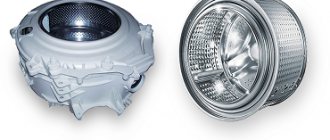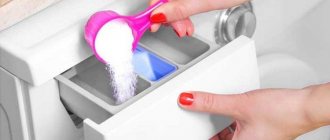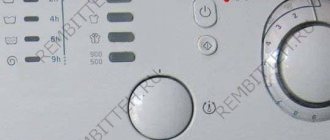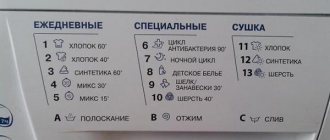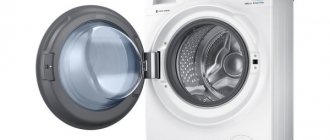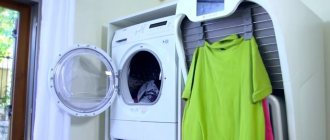Let's consider which material is better for the washing machine tank: stainless steel, plastic, steel or polynox. The choice of SMA depends not only on price, water and light consumption, but also on the materials from which the components are made.
An important part of the car is the tank. It affects the convenience and service life of the entire unit.
- Purpose of the SMA tank
- Stainless steel
- Plastic
- Metal
- Polynox
- Catalog of washing machines with reviews
Purpose of the SMA tank
The washing machine tank cannot be assessed visually when purchasing. Therefore, you need to immediately find out about the material from which it was made.
Polynox tank
Do not confuse the tank and the drum. The laundry is placed in the drum, and it is this drum that rotates during washing. Tank is the container where the drum is placed. Water and detergents are poured there. This mixture enters the drum through special holes through the pipe.
The tank takes on a lot of load. The water heats up in it, aggressive chemicals get into it, and some object may accidentally fall out of the drum. These factors can significantly accelerate the failure of a part. To prevent this from happening, you should take care in advance of choosing a car with a suitable tank.
Do you turn off the water tap after washing?
Oh yes! No.
The drum is made of stainless steel. Tanks are made from the following materials:
- stainless steel;
- plastic;
- metal;
- polynox.
Each of them has its own advantages and disadvantages and affects the price and life of the washing machine. If it breaks down, most often you have to replace the entire washing machine, so you should take your choice seriously.
What material is the tank made of?
Further in the article we will consider all known options.
Plastic
Each company has its own secrets and uses plastic raw materials with certain characteristics. For example, carborane is reminiscent of stainless steel material in its durability, strength and reliability. And the thermal insulation and vibration reduction properties are even superior to stainless steel.
The most commonly used polymers are carborane, carbotec, carferon, silitek, and polynox. They all have one common feature - the main component is considered to be a special polypropylene material containing calcium carbide. This additive significantly increases the strength of the plastic and makes it resistant to detergents used in washing. The quality of the tank itself changes depending on the amount of special additives in the plastic.
The main advantages of raw materials include:
- resistance to corrosion;
- high strength indicators;
- moderate weight;
- the material is not exposed to moisture;
- the noise level decreases during element rotation;
- electrical energy is saved;
- resistance to aggression of chemical compounds.
There are many positive qualities, but you should know that household products with plastic tanks fail more often and are of little use for mechanical impacts.
It would be fair to note that the development of plastic raw materials does not stand still, and each manufacturer adds its own “zest” to such raw materials, which allows improving strength and reliability. In addition, the raw materials are considered cheap, which affects the overall cost of the washing machine.
In addition to the positive characteristics, there are also negative aspects. It has already been noted that companies are trying in every way to improve plastic tanks. But the material still remains brittle and susceptible to splitting, which is its main weak point.
If transportation rules are violated or the bolts securing the drum are left behind, the container may be damaged. After this, the machine will no longer be able to be used. You will have to purchase a new unit or look for a similar replacement tank.
With good quality plastic raw materials and compliance with operating rules, the tank will last from twenty to twenty-five years.
Stainless steel
This high-quality metal is considered traditional and is very popular as a raw material for tanks. It will be enough to remember the old models of cars that are still found in garages and sheds. The unit has long since lost its functionality, but the stainless steel tank continues to maintain excellent external characteristics. And a long operational period is not considered the only advantage of such raw materials.
Positive points include:
- strength and resistance to mechanical damage;
- excellent resistance to high temperatures and chemicals;
- complete absence of mold and mildew from wet conditions, minimal opportunities for the development of harmful microorganisms.
It may seem strange that there are also negative aspects. The main one is the high pricing policy, depending on the quality of the material. A metal tank has a higher level of heat transfer; the water in it cools down much faster, which results in unnecessary consumption of electrical energy spent on heating. Another significant problem with a metal assembly is vibration. At maximum speeds, you can hear quite strong sounds, which cannot be said about models with tanks made of other materials.
Polynox tank
Quite often you can hear stories from sellers of laundry washing machines that contain this term. It immediately becomes clear that the material is new. It remains to be seen what exactly is made from it, and how such components affect the performance of household appliances.
The name of the material implies a commercial version of the name of polypropylene raw materials, the characteristics of which are slightly modified by the addition of special chemical compounds.
Today, polynox is used in the manufacture of tanks for washing machines, and the raw material has already gained well-deserved popularity. There are reasons for this:
- reasonable cost;
- ease of processing;
- The manufactured elements have excellent characteristics.
Polynox is not considered the only plastic option used to make tanks. Some manufacturers use more durable and ductile carborane, however, its cost increases by one and a half times.
In the model range from Kandy, the tanks are made of silitek. In its qualities it resembles polynox.
Metal enameled version
Such tanks have long been discontinued. Distinctive features are considered to be a good level of reliability and protection from corrosion. This tank weighs quite a lot. The element is durable and does not crack during transportation and temperature changes. The tank is reliable when washing any laundry.
During prolonged use, chips may form due to impacts from foreign objects caught in the drum. Damaged enamel coating ceases to perform its main function, crumbles, becomes covered with rust stains and is destroyed. The tank begins to leak and needs to be completely replaced.
Today, enamel tanks are not sold separately. If your machine with such an element begins to leak, you will have to purchase a new “helper”.
Stainless steel
The most expensive and durable material. It is assumed that a stainless steel tank can last at least 100 years. Of course, no one checked this, since no machine is capable of working that long.
Stainless steel tank
Stainless steel is valued for the following qualities:
- durability;
- impact resistance;
- not subject to corrosion.
The disadvantages include the machine being too noisy, its high price and high energy consumption. The hum occurs due to friction and knocking on the metal drum, as well as the low soundproofing properties of steel.
The price of the machine is determined by the cost and durability of the material. Water in a metal container cools down faster, you have to heat it up more often, and as a result, more energy is wasted. Significant weight of a part is also considered a disadvantage, but not always.
Expert opinion
I work in the household appliance repair industry. Extensive experience in restoring washing machines and dishwashers.
Ask a Question
Any washing machine repairman will tell you that the heavier the device, the better.
It should be remembered that stainless steel is an expensive material. With high-quality soldering, the price of the machine cannot be low. If a washing machine is offered at a very attractive price, it may turn out to be of poor quality and will not last long.
Stainless steel tanks are the most popular. However, finding them can be difficult. practices the use of stainless steel tanks. Many manufacturers most often use plastic or polynox to reduce the cost of their products.
Do you store laundry in the washing machine?
Oh yes! No.
Other qualities of the machine element
Before you buy a washing machine, you should find out how much laundry it can wash in one load. For a large family, it is recommended to purchase models with a load of at least six kilograms.
Often the surface of the tank is coated with a special composition that brings benefits by having a disinfecting effect on the water.
Plastic raw materials and stainless steel are popular today. Each of the materials is quite acceptable and has a long service life. Everything is clear with the advantages; for comparison, here are the negative points:
- a stainless steel tank makes more noise compared to its plastic counterpart;
- elements made from plastic raw materials are considered brittle and cannot withstand mechanical stress.
Note that plastic raw materials are gradually pushing stainless steel out of the production process. It is quite possible that such machines will soon cease to be produced. Which option is better is up to you to decide.
Plastic
Quite a popular material. Has many advantages:
- easy;
- inexpensive;
- low thermal conductivity;
- does not create excessive noise;
- does not rust or leak.
Biggest drawback: fragility. Much easier to damage than metal. Most often this happens when moving.
It also happens that during washing, some object gets caught between the drum and the tub. In this case, the latter may crack. You will have to change the part or buy a new unit. Both will not be cheap.
Plastic tank
Gray plastic is considered the most unreliable. It quickly deteriorates, and you have to buy a new washing machine.
Features of the enamel coating of tanks
In the recent past, manufacturers made cars with enamel tanks. However, their service life was short. As soon as the smallest crack appeared on the enamel coating, the metal underneath began to quickly rust.
The version of models with enameled metal has its own characteristics. Both positive and negative.
POSITIVE SIDES
— Works reliably, even if you place any laundry. — Enamel is a protective layer that prevents corrosion from appearing on the metal.
What material are the containers made of stronger? There is no clear answer to the question. During transportation, it is almost impossible to damage models with enameled metal. They do not crack even with large temperature changes.
NEGATIVE SIDES
- An impressive mass. — The container is defenseless against impacts.
Long periods of use lead to chips appearing on the enamel container. This is caused by impacts from foreign objects. The enamel begins to crumble in areas where there is damage.
IMPORTANT! Once the protective layer disappears, rust quickly covers the metal, leading to complete destruction. Some time will pass and you will begin to worry about leaks. In this situation, you need to replace the tank or buy new equipment.
We emphasize that containers from this option are practically no longer produced. As it turned out, there were too many accidents when using them. And in the production of tanks they began to use plastic or a stainless steel base.
Metal
Enameled steel was previously used as metal for tanks. This material is not very suitable for washing machines. When carrying or during washing, the surface may chip. Rust appears in this place, and later there is a hole and a leak.
For this reason, such tanks are not currently produced. They are only found in old cars. If the tank in such a device leaks, practically nothing can be done. Alternatively, use a welding machine. But such a decision is very controversial. It's better to buy a new car.
Expert opinion
I work in the household appliance repair industry. Extensive experience in restoring washing machines and dishwashers.
Ask a Question
But with careful use, enameled steel lasts for many years. Some machines with parts made of this metal are still washed for their careful owners.
Features and purpose
Many washing machine owners mistakenly assume that the tank and drum are the same part in household appliances. A drum is a container into which dirty things are placed. It is always made of stainless steel. Tank is a container for the drum. Liquids, powders, conditioners and other laundry detergents are poured into it.
All this enters the drum through special pipes.
Tanks are:
- collapsible;
- non-separable.
The former consist of two halves connected to each other using fasteners, while the latter are a one-piece, non-separable structure.
The tank is an important part in any washing machine. Water is poured into it (depending on the machine model, from 30 to 60 liters). To avoid strong vibration during washing, spinning and rinsing, the tank is not rigidly attached to the body. To soften vibrations, springs are located in the upper part, and a shock-absorbing system is located in the lower part. For these purposes, manufacturers also install concrete counterweights on containers.
The washing machine tank takes on a colossal load. Water is heated in it, chemically aggressive laundry detergents enter here, and it can withstand sudden temperature changes. Therefore, the quality and durability of this part will depend on the type of raw materials used in the production of tanks. Let's look at the most popular materials used by manufacturers.
Polynox
Polynox tank
One of the most popular materials, which includes polypropylene and calcium carbide. Has the same advantages as plastic. In addition to polynox, there are other similar substances. They differ slightly in composition and are called composite materials.
The varieties are as follows:
- carferon;
- carborane;
- silytek;
- carbotek.
Depending on what the manufacturer added to the composition, the quality of the resulting substance will differ. For example, carborane is stronger than polynox. But since there are no significant differences, composite materials for tanks are considered together.
Products made from polynox can last until the end of the life of the washing machine. Each manufacturer is trying to develop more and more durable polymer options. Some of them already have the properties of both plastic and metal. Such parts do not break down for up to 30 years.
So, now the most popular materials for making washing machine tanks are stainless steel, plastic, polynox and its variations. The choice is determined by a person’s finances and living conditions. If you move frequently, there is a high probability of damaging the plastic tank. But it is lighter, cheaper and less noisy. And yet, experts do not recommend looking at the material first.
Power consumption, brand, and technical characteristics are considered more important. The easiest way is to select several cars with suitable functions, price and country of origin, and from them choose the best one with the required tank.
Polynox, carboran and silytek - what is it?
All of the materials listed are polymers. They are very similar, but differ in some operational characteristics.
Polynox
In the very name “polinox”, buyers hear the “taste” of plastic. And their intuition does not deceive them, this is indeed one of the polymers - polypropylene. After adding some additives to it, it slightly changes its characteristics and transforms into polynox. This material contains additives that help reduce vibration of the drum and increase its thermal insulation properties.
In automatic washing machines (AWA), this polymer is used to make the most important structural element - the tank. Today, plastic tanks have become widespread, due to the advantageous properties of the material. It is cheap, easy to process, and parts made from it have excellent performance characteristics.
There are other polymers used in the production of SMA. Each manufacturer includes different additives in the plastic, so the names of the polymers may differ. So, polynox has a similar analogue - polyplex. It is not afraid of high temperature, corrosion, water, and ensures the device is silent. Polyplex conducts heat well, which saves energy. But like all plastics, this material is quite fragile.
Carborane
This composite material is Electrolux's own development. It is more reliable than polyplex. Compared to the latter, carborane is less brittle. It costs 1.5 times more than other polymers.
Benefits of carboran:
- practically does not absorb odors;
- is a dielectric, therefore safe;
- withstands mechanical and chemical loads;
- saves energy due to high thermal insulation properties;
- good sound insulator - reduces noise during operation of the SMA.
Silitek
This composite material is almost similar to polynox. It is developed by Candy Hoover Group. Its properties are similar to basalt - a natural stone of volcanic origin, resistant to alkalis and acids, and dolomite - a natural mineral, moisture-resistant, but fragile. Silitek is resistant to heat and has good sound absorption. Has excellent heat-insulating properties.
Washing machine drum: perforated
On the side surfaces of any cylinder inside the tank you can observe many small holes called perforations.
This is necessary for water to flow from the tank to the drum and back during washing. But sometimes such holes can affect the wear and tear of the laundry. Why is this happening? The fact is that during washing, when the cylinder rotates, a centrifugal force acts on the things inside it, which seems to “press” them into these perforated holes. As a result, the fabric fibers wear out over time and the item wears out faster.
Important. At high spin speeds, fabrics wear out faster. Therefore, it is recommended to spin delicate items at the lowest speed, choosing the appropriate washing mode.
Manufacturers of washing machines are trying to change such situations for the better by developing special algorithms and operating programs for washing devices. By providing the best washing quality, they at the same time minimize the wear and tear of fabrics. For this purpose, manufacturers also make drums that have a special internal surface.
Honeycomb drums
Drums of this type were patented by Miele, so they cannot be found in washing machines from other manufacturers.
Features of Honeycomb Drums
The developers of this company turned their attention to the design of honeycombs, which are quite stable, although they are made of soft material. Manufacturers have used similar shapes for the surfaces of the cylinders of their washing units. They covered them inside with raised, specially stamped hexagons.
The perforation with such holes has a smaller diameter, which is why the washing solution lingers inside the drum for a longer time, and the fabric is practically not drawn into them, washing is much more gentle than usual. As the developers themselves say:
- cylinders of this type help reduce energy consumption;
- laundry is washed more carefully;
- There are no welded parts inside the drum, which means their service life is quite long.
Cell drums
Honeycomb washing machine drum with convex texture
Drip drums
The inner surface of this type of drum is not covered with honeycomb-like holes, but with special protrusions that are shaped like drops. This type of coating was developed by Bosch specialists. One side of these droplet protrusions is gently sloping, and the other is steeper. This coating principle is applied inside the drums, which are called VarioSoft. The developers have provided this:
- firstly, a delicate effect on fabrics (wool, silk) during washing when the cylinder rotates in one direction;
- secondly, a more intensive wash, removing all dirt on cotton or linen fabrics, when rotating the cylinder in the other opposite direction.
VarioSoft washing machine drums
Pearl Drum
"Pearl Drum" or pearl drum, designed for Hansa washing machines. It is named so because its internal surfaces are covered with protrusions in the form of hemispheres, similar to a scattering of pearls of different sizes. This was also done to prevent fabric fibers from being drawn into the holes on the surface of the cylinder. According to the developers, this perforation design should protect things from wear during spinning even at high speeds up to 1400 rpm.
Wave Drum
This type of perforation is a type of “Pearl Drum”, translated as “wave drum”. Its inner walls are covered with special hemispheres that bend in waves along the entire diameter. The developers claim that this design can improve the movement of laundry during washing inside the drum and protect fabrics from wear.
Diamond Drum
Samsung continued the idea of the Miele developers and created its high-tech advanced drum “Diamond Drum”, inside of which the perforations are located in small recesses resembling the shape of a pyramid. The reduced diameter of these holes prevents fabric fibers from being drawn through them, protecting items from wear and tear. Such “pyramids” are similar to the cutting of precious stones, which is why they got their name “Diamond Drum”.
Diamond Drum
What is better to choose
Washing machines with a stainless steel tank are considered the most reliable and durable. But in terms of price, such SMAs are significantly more expensive than analogues with a reservoir made of composite materials. The stainless steel tank weighs a lot and is quite noisy during operation.
Composite plastic analogues are lightweight, less noisy and inexpensive, which allows manufacturers to offer equipment at a more affordable price.
Advice! When using SMA with plastic tanks, you should be careful during transportation and carefully check the pockets of your items before putting them in the wash. Compliance with such measures will extend the life of an important component.
The quality of polymers is improving year after year through the use of new manufacturing technologies. Also, in some models, manufacturers practice installing combined tanks. From year to year, the electronic technologies used to equip the SMA are being modernized. In modern conditions, equipment with a plastic tank is an economically viable option, subject to careful operation.
Purpose of the tank and its types
Structurally, the tank is a container for the drum, where the user of the machine puts things for washing . Through the inlet pipe into the container from the water pipe, the automatic machine draws water for washing. In the tank, the water is heated to the desired temperature. The amount of liquid collected depends on the model and the set washing program.
Using a special mechanism, washing powder and conditioner are supplied into the container. The soap solution enters the drum, which rotates during washing, through the holes. At the end of the washing program, liquid is discharged into the sewer through the outlet pipe.
According to the design, the water tank can be collapsible or solid. The collapsible design consists of two halves connected with bolts. To reduce oscillatory processes that occur during washing, developers use special shock-absorbing mechanisms: springs, counterweights, etc.
When operating a washing machine, the tank experiences heavy loads: temperature changes, exposure to chemicals, vibration. It is important that the part is made of high-strength materials.
